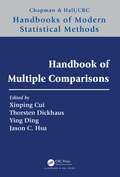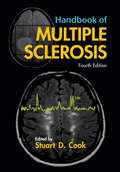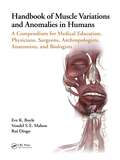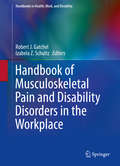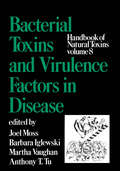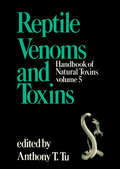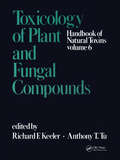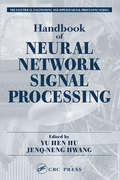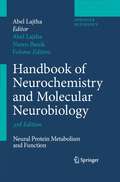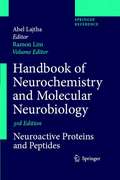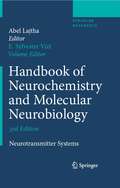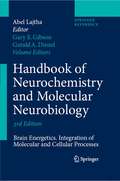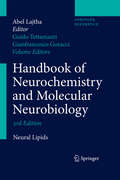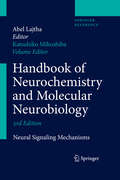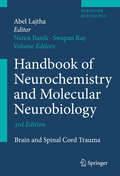- Table View
- List View
Handbook of Multiple Comparisons (Chapman & Hall/CRC Handbooks of Modern Statistical Methods)
by Xinping Cui, Thorsten Dickhaus, Ying Ding, Jason C. HsuWritten by experts that include originators of some key ideas, chapters in the Handbook of Multiple Testing cover multiple comparison problems big and small, with guidance toward error rate control and insights on how principles developed earlier can be applied to current and emerging problems. Some highlights of the coverages are as follows. Error rate control is useful for controlling the incorrect decision rate. Chapter 1 introduces Tukey's original multiple comparison error rates and point to how they have been applied and adapted to modern multiple comparison problems as discussed in the later chapters. Principles endure. While the closed testing principle is more familiar, Chapter 4 shows the partitioning principle can derive confidence sets for multiple tests, which may become important as the profession goes beyond making decisions based on p-values. Multiple comparisons of treatment efficacy often involve multiple doses and endpoints. Chapter 12 on multiple endpoints explains how different choices of endpoint types lead to different multiplicity adjustment strategies, while Chapter 11 on the MCP-Mod approach is particularly useful for dose-finding. To assess efficacy in clinical trials with multiple doses and multiple endpoints, the reader can see the traditional approach in Chapter 2, the Graphical approach in Chapter 5, and the multivariate approach in Chapter 3. Personalized/precision medicine based on targeted therapies, already a reality, naturally leads to analysis of efficacy in subgroups. Chapter 13 draws attention to subtle logical issues in inferences on subgroups and their mixtures, with a principled solution that resolves these issues. This chapter has implication toward meeting the ICHE9R1 Estimands requirement. Besides the mere multiple testing methodology itself, the handbook also covers related topics like the statistical task of model selection in Chapter 7 or the estimation of the proportion of true null hypotheses (or, in other words, the signal prevalence) in Chapter 8. It also contains decision-theoretic considerations regarding the admissibility of multiple tests in Chapter 6. The issue of selected inference is addressed in Chapter 9. Comparison of responses can involve millions of voxels in medical imaging or SNPs in genome-wide association studies (GWAS). Chapter 14 and Chapter 15 provide state of the art methods for large scale simultaneous inference in these settings.
Handbook of Multiple Sclerosis (Neurological Disease and Therapy)
by Stuart D. CookFilled with an abundance of reader-friendly and quick-reference tables and figures, this Fourth Edition spans the etiology, epidemiology, clinical features, diagnosis, pathology, and treatment of multiple sclerosis (MS). Surpassing other texts on the topic, this reference provides recommendations and research updates from renowned authorities in th
Handbook of Muscle Variations and Anomalies in Humans: A Compendium for Medical Education, Physicians, Surgeons, Anthropologists, Anatomists, and Biologists
by Rui Diogo Eve K. Boyle Vondel S. MahonMost textbooks and atlases of human anatomy chronicle only a few cases of muscle variations in the "normal" human population, or of muscle anomalies within congenital malformations. Consequently, there is a misconception of what is considered "normal" human anatomy and what that looks like. Each person within the "normal" population has at least a few muscle variations, and there are millions of individuals born globally each year with muscle anomalies. There are crucial knowledge gaps between what is taught, what students learn, what textbooks and atlases show, and what truly happens in nature and within our species. This handbook fills this gap by: 1) providing a comparative evolutionary context for muscle variations and defects in humans, 2) summarizing the major types of variations and anomalies found in humans, and 3) including didactic figures for a visually engaging learning experience. This book is of interest to students, professors, and researchers in biological anthropology, comparative anatomy, functional morphology, zoology, and evolutionary and developmental biology, as well as to clinicians and practicing health professionals. Key Features Summarizes most recorded variations and anomalies for each muscle in the human body Provides information on the comparative anatomy of each muscle, including evolutionary differences from our closest living relatives, the apes Includes didactic illustrations of the variations and anomalies for a visually engaging learning experience Comprehensively reviews literature to document prevalence information for each variation and anomaly, within humans Related Titles Brown, D. E. Human Biological Diversity, 2nd ed. (ISBN 978-1-138-03753-3) Diogo, R., et al. Understanding Human Anatomy and Pathology: An Evolutionary and Developmental Guide for Medical Students (ISBN 978-1-4987-5384-5) Diogo, R. Muscles of Chordates: Development, Homologies, and Evolution (ISBN 978-1-138-57116-7)
Handbook of Musculoskeletal Pain and Disability Disorders in the Workplace
by Izabela Z. Schultz Robert J. GatchelThis book addresses the complexity of preventing, diagnosing, and treating musculoskeletal pain and disability disorders in the workplace. Divided evenly between common occupational pain disorders, conceptual and methodological issues, and evidence-based intervention methods, this comprehensive reference presents current findings on prevalence, causation, and physical and psychological aspects common to these disorders. Attention is given to working-world concerns, including insurance and compensation issues and AMA guidelines for disability evaluations. Also, specialized chapters offer lenses for understanding and administering the best approaches for treating specific pain disorders, and explore what workplaces can do to accommodate affected employees and prevent injuries from occurring in the first place.
Handbook of Musculoskeletal Tumors
by Matthew Wallace Frank FrassicaA quick-reference handbook with more than 100 figures, charts, and images, Handbook of Musculoskeletal Tumors provides a wide-ranging overview of musculoskeletal tumors for the practicing clinician. From a pathological fracture in the emergency department to a soft tissue tumor in the clinic, musculoskeletal tumors present in clinical practice yet receive minimal exposure in training. Edited by Drs. Matthew T. Wallace and Frank J. Frassica, Handbook of Musculoskeletal Tumors provides readers with concise recommendations for their encounters with diseases including: Latent bone lesions and active and aggressive benign bone lesions Osteosarcoma, Ewing sarcoma, and primary lymphoma of bone Myeloma and metastatic bone disease, chondrosarcoma, osteochondroma, multiple hereditary exostoses, Ollier disease, and Mafucci syndrome Benign soft tissue tumors, including lipomatous tumors, nerve sheath tumors, and myxoid, fibrous, and vascular lesions Soft tissue sarcomas, including undifferentiated pleomorphic sarcoma, liposarcomas, synovial sarcoma, rhabdomyosarcoma, and epithelioid sarcoma Anatomic-specific considerations, including intra-articular lesions and hand, foot, and spine tumors Written for primary care providers, practicing orthopedists and surgeons, residents and students in training, physician assistants, and nurses and nurse practitioners, Handbook of Musculoskeletal Tumors is a practical guide to help practitioners recognize and diagnose suspicious lesions, order appropriate testing, and facilitate prompt referrals to trained musculoskeletal oncologists when appropriate for additional management.Included with the text are online supplemental materials for faculty use in the classroom.
Handbook of Natural Toxins, Volume 8: Bacterial Toxins and Virulence Factors in Disease
by Joel MossThis volume describes the structure and function of bacterial toxins and presents a comprehensive review of virulence factors, providing recent information concerning cell physiology and biochemistry, as well as new toxin tools for experimental studies and clinical therapy. A wide variety of toxic proteins, including the toxins that cause diptheria
Handbook of Natural Toxins: Reptile Venoms and Toxins (Handbook Of Natural Toxins Ser.)
by Anthony T. TuIn 24 contributed chapters, 37 international specialists describe the latest developments in research on snake venom including different types of venoms and toxins, actions, antidotes, and applications and summarize what is known to date on Gila monster and frog toxins. Some 70 tables provide essent
Handbook of Natural Toxins: Toxicology of Plant and Fungal Compounds
by R. F. KeelerFeaturing the work of 55 leading authorities on natural toxins, this new volume highlights the diversity of chemical classes among toxins, the range of effects on biological systems, and the variety of expressions of toxicoses.Supplying findings that have yielded significant solutions to practical toxicoses problems, this exceptional reference describes the toxicology and chemistry of toxic and phar macologically active compounds from plants and fungi ... discusses the occurrence, incidence, and epidemiology of several types of plant and fungal compound-induced toxicoses in man and animals ... details the structure/activity relation of several plant and fungal toxins and plant teratogens ... covers the toxicologic effects of many plant and fungal compounds on the lung, liver, heart, gastrointestinal tract, muscle, skin, and other organs ... considers the potential usefulness of plant and fungal substances as herbicides, pesticides, and insecticides ... examines plant/herbivore, plant/plant, and plant/fungal interactions as related to plant and fungal toxins ... presents current techniques used in toxicology and teratology studies ... and more!Toxicology of Plant and Fungal Compounds is an indispensable reference for toxicologists; biologists; natural product and organic chemists and biochemists; veterinarians; plant pathologists; land managers; health department personnel; and graduate school students in toxicology, biology, pharmacology, and public health.
Handbook of Nephrology
by David J. Leehey Irfan MoinuddinNow entirely in four-color for the first time, Handbook of Nephrology, Second Edition is a concise introduction to Nephrology and features vividly-described patient cases that illuminate core concepts and topics, such as patient history, physical assessment, diagnosis, lab findings and more. This edition has been expanded with numerous additional cases, which now reflect the day-to-day activities of a practicing nephrologist.
Handbook of Nephrology and Hypertension
by Christopher S. Wilcox Michael Choi Mark S. Segal Limeng Chen Winfred W. WilliamsConcise, thorough, and easy to use, Handbook of Nephrology and Hypertension 7th Edition, provides authoritative guidance on diagnosing and treating patients with a wide range of kidney disorders and hypertension, including coverage of dialysis and transplantation. Lead editor Dr. Christopher Wilcox and his team of section editors Drs. Michael Choi, Limeng Chen, Winfred N. Williams, and Mark S. Segal oversee a group of expert authors, both faculty and fellows, who focus on common problems and challenges in this complex field. Brief, focused chapters contain abundant figures and algorithms and have been updated to reflect new findings in renal cystic diseases, new drugs used for hypertension, transplantation and renal protection, and much more.
Handbook of Neural Network Signal Processing (Electrical Engineering & Applied Signal Processing Series)
by YU HEN HU AND JENQ-NENG HWANGThe use of neural networks is permeating every area of signal processing. They can provide powerful means for solving many problems, especially in nonlinear, real-time, adaptive, and blind signal processing. The Handbook of Neural Network Signal Processing brings together applications that were previously scattered among various publications to provide an up-to-date, detailed treatment of the subject from an engineering point of view.The authors cover basic principles, modeling, algorithms, architectures, implementation procedures, and well-designed simulation examples of audio, video, speech, communication, geophysical, sonar, radar, medical, and many other signals. The subject of neural networks and their application to signal processing is constantly improving. You need a handy reference that will inform you of current applications in this new area. The Handbook of Neural Network Signal Processing provides this much needed service for all engineers and scientists in the field.
Handbook of Neuro-Urology
by David N. RushtonEmphasizing the clinical problems surrounding urogenital tract dysfunction, this up-to-date reference details the basic science, differential diagnosis, and treatment of a wide range of neurourological conditions.Covering recent advances in the neurobiology of the pelvic organs, the Handbook of Neuro-Urology reviews the neural control processes that govern pelvic organs discusses the pathogenic mechanisms behind neurological and smooth muscle disorders that produce bladder dysfunction describes the management of impaired bladder, bowel, and sexual function after brain damage and spinal cord injury examines various conditions that affect the autonomic nervous system and specifically result in bladder and sexual dysfunction investigates lower urinary tract function in the elderly suggests practical measures to manage urinary incontinence such as the use of pads, underpants, and appliances and more!
Handbook of Neurobehavioral Genetics and Phenotyping
by Valter TucciThe Handbook of Behavioral Genetics and Phenotyping represents an integrative approach to neurobehavioural genetics; worldwide experts in their field will review all chapters. Advanced overviews of neurobehavioural characteristics will add immense value to the investigation of animal mutants and provide unique information about the genetics and behavioural understanding of animal models, under both normal and pathological conditions. Cross-species comparisons of neurobehavioural phenotypes will pave the way for an evolutionary understanding of behaviour. Moreover, while biological sciences are progressing towards a holistic approach to investigate the complexity of organisms (i.e., “systems biology” approach), an integrated analysis of behavioural phenotyping is still lacking. The Handbook of Behavioral Genetics and Phenotyping strengthens the cross-talk within disciplines that investigate the fundamental basis of behaviour and genetics. This will be the first volume in which traditionally distant fields including genomics, behaviour, electrophysiology, neuroeconomics, and computational neuroscience, among others, are evaluated together and simultaneously accounted for during discussions of future perspectives.
Handbook of Neurochemistry and Molecular Neurobiology
by Abel Lajtha Naren BanikThe Second Edition of the Handbook of Neurochemistry, which was published about 24 years ago, consisted of 10 volumes. The present, Third Edition, The Handbook of Neurochemistry and Molecular Biology, is over twice as large; indicating a great expansion of neuroscience in the past two decades. We now have not only more data on brain mechanisms relating to behavior (mental activity and cognitive processes), but we understand in some detail the mechanisms of these functions. The past editions focused purely on neurochemical aspects – the new edition reflects the need of interdisciplinary approach for understanding neural mechanisms. In addition to metabolic processes, the 17 new volumes explore the functions of peptides, transport, immunology and other processes not well understood 24 years ago. Several volumes deal with pathological changes and with repair and therapy of both mental and neurological pathologies. The purpose of this edition is to provide an evaluation of the results of investigations; to serve as a guide rather than enumerating all the available findings in detail – it indicates future possibilities and the existing knowledge in neuroscience. The significance of understanding neural processes needs no emphasis – its potential is primary in mental and neural pathology, but also in physiological importance. The volumes should serve as an aid to researchers expanding our knowledge and to educators training the next generation of neuroscientists and clinicians.
Handbook of Neurochemistry and Molecular Neurobiology
by Abel Lajtha Maarten E.A. ReithTitle is also available as part of a set: Handbook of Neurochemistry and Molecular Neurobiology (978-0-387-30426-7)
Handbook of Neurochemistry and Molecular Neurobiology
by Abel Lajtha Ramon LimThis volume is a collection of a variety of brain proteins and peptides whose structures and functions are relatively well known. Each chapter provides a succinct and up-to-date summary of a protein or peptide as well as a review of the individual's contributions to the field. The volume explores the progress that has been made in the field over the past few years and provides insight into the field today.
Handbook of Neurochemistry and Molecular Neurobiology
by Abel Lajtha Sylvester E. ViziUnderstanding the biology of brain function is a great challenge and a major goal of modern science. The brain is one of the last great frontiers in science, and the unraveling of its mysteries is comparable in complexity to efforts in space exploration. A fundamental goal of neuroscience is to understand how neurons generate behavior and the pathophysiology of different mental and neurological diseases. The aim of this book is to describe recent discoveries about the basic operations of the brain and to provide an introduction to the adaptations for specific types of information processing.
Handbook of Neurochemistry and Molecular Neurobiology
by Abel Lajtha Gerry A. Dienel Gary E. GibsonThe Second Edition of the Handbook of Neurochemistry, which was published about 24 years ago, consisted of 10 volumes. The present, Third Edition, The Handbook of Neurochemistry and Molecular Biology, is over twice as large; indicating a great expansion of neuroscience in the past two decades. We now have not only more data on brain mechanisms relating to behavior (mental activity and cognitive processes), but we understand in some detail the mechanisms of these functions. The past editions focused purely on neurochemical aspects – the new edition reflects the need of interdisciplinary approach for understanding neural mechanisms. In addition to metabolic processes, the 17 new volumes explore the functions of peptides, transport, immunology and other processes not well understood 24 years ago. Several volumes deal with pathological changes and with repair and therapy of both mental and neurological pathologies. The purpose of this edition is to provide an evaluation of the results of investigations; to serve as a guide rather than enumerating all the available findings in detail – it indicates future possibilities and the existing knowledge in neuroscience. The significance of understanding neural processes needs no emphasis – its potential is primary in mental and neural pathology, but also in physiological importance. The volumes should serve as an aid to researchers expanding our knowledge and to educators training the next generation of neuroscientists and clinicians.
Handbook of Neurochemistry and Molecular Neurobiology
by Abel Lajtha Steffen Roßner Regino Perez-PoloIn the animal nervous system, a very high metabolic turnover, fragile but steep ionic gradients, and morphological and structural constraints - dictated by the necessity for prompt neuronal transmission of electrical impulses and necessary plasticity - result in a highly fragile organ system. Here, we address a small sampling of major constituents of neural function at the cellular and molecular level that play important roles in development and aging, two endogenous processes that embody features of allostasis or the dynamic shifts in set points for specific homeostatic mechanisms associated with development and aging. These chapters stress the dynamic features of neuronal responses to internal (developmental) cues or the more harmful external events (injury and disease) in a modern perspective.
Handbook of Neurochemistry and Molecular Neurobiology
by Abel Lajtha Armen Galoyan Hugo BesedovskyHere is yet another of Springer's authoritative Major Reference Works. The release of these is a huge publishing event in itself, and this handbook on neurochemistry and molecular neurobiology is no exception. Required reading for neuroscientists and neurochemists, it contains data on multiple immunomodulators, many of which are also the products of hypothalamic brain cell neurosecretion. With contributions from dozens of researchers worldwide, and edited by two leading authorities in the field, this is information you can trust. Neuroimmunology is one of the most rapidly developing branches of Neurobiology, and this volume contains chapters that focus on a huge range of topics including the relationship between neuroimmunology and the pathogenesis of different nervous diseases.
Handbook of Neurochemistry and Molecular Neurobiology
by Abel Lajtha Joshua Kantrowitz Daniel C. JavittThis volume of the Handbook of Neurochemistry and Molecular Neurobiology focuses on neurochemical aspects of schizophrenia. Chapters cover the full range of schizophrenia symptoms and anatomical pathologies from neurochemical and molecular biology perspectives. Topics include changes in neurotransmitter systems, alteration in receptors, neurotransmitter release, genetic factors, protein alterations, and redox dysregulation.
Handbook of Neurochemistry and Molecular Neurobiology
by Abel Lajtha Gianfrancesco Goracci Guido TettamantiThe Second Edition of the Handbook of Neurochemistry, which was published about 24 years ago, consisted of 10 volumes. The present, Third Edition, The Handbook of Neurochemistry and Molecular Biology, is over twice as large; indicating a great expansion of neuroscience in the past two decades. We now have not only more data on brain mechanisms relating to behavior (mental activity and cognitive processes), but we understand in some detail the mechanisms of these functions. The past editions focused purely on neurochemical aspects - the new edition reflects the need of interdisciplinary approach for understanding neural mechanisms. In addition to metabolic processes, the 17 new volumes explore the functions of peptides, transport, immunology and other processes not well understood 24 years ago. Several volumes deal with pathological changes and with repair and therapy of both mental and neurological pathologies. The purpose of this edition is to provide an evaluation of the results of investigations; to serve as a guide rather than enumerating all the available findings in detail - it indicates future possibilities and the existing knowledge in neuroscience. The significance of understanding neural processes needs no emphasis - its potential is primary in mental and neural pathology, but also in physiological importance. The volumes should serve as an aid to researchers expanding our knowledge and to educators training the next generation of neuroscientists and clinicians.
Handbook of Neurochemistry and Molecular Neurobiology
by Abel Lajtha Katsuhiko MikoshibaThis volume of the Handbook of Neurochemistry and Molecular Biology focuses on molecular events involved in synapse formation, synaptic plasticity and ongoing neural activity. The volume explores axonal growth cones, synapse development, and mechanisms of LTP and LTD, and calcium dynamics. Particular attention is given to function and trafficking of membrane proteins including various ion channels, aquaporines, gap junctions.
Handbook of Neurochemistry and Molecular Neurobiology
by Abel Lajtha Swapan K. Ray Naren L. BanikThis volume of the Handbook of Neurochemistry and Molecular Neurobiology characterizes pathologies resulting from traumatic brain and spinal cord injury as well as various neurodegenerative diseases, demyelinating diseases, viral infection, nervous system tumors, and neuropathies. Special attention is given to mechanisms and pathways of cell death in the brain. The contributors explore and comment on current treatment strategies including facilitating neuroprotection and regeneration and treatment using stem cells.
Handbook of Neurochemistry and Molecular Neurobiology: Acute Ischemic Injury and Repair in the Nervous System (Handbook Of Neurochemistry And Molecular Neurobiology Ser.)
by Abel Lajtha Pak H. ChanStroke is a global health problem affecting approximately 15 million people annually in the world and about 700,000 in the United States. It is the third leading cause of death and the most common cause of disability in most developed countries. Acute Ischemic Injury and Repair in the Nervous System is intended to provide the most up-to-date knowledge of the mechanisms of neuronal death and repair after stroke. It is our belief that this volume of the Handbook of Neurochemistry and Molecular Neurobiology provides an excellent review of the tremendous advances of the past decades in the neurochemical and molecular biological aspects of cerebral ischemia. It is hoped that these advances will provide an impetus for basic scientists and clinicians to further their translational research and to promote the insights for development of therapeutic interventions for stroke.
